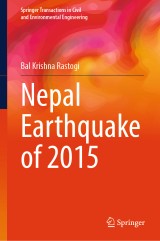Details

Nepal Earthquake of 2015
Springer Transactions in Civil and Environmental Engineering
|
CHF 153.50 |
|
| Verlag: | Springer |
| Format: | |
| Veröffentl.: | 08.08.2024 |
| ISBN/EAN: | 9789819746842 |
| Sprache: | englisch |
Dieses eBook enthält ein Wasserzeichen.
Beschreibungen
<p>This book describes the source parameters, faulting mechanism, slip distribution, rupture pattern, and aftershock behaviour of the Nepal Earthquake of 2015. This book sheds light on the damage pattern and the geodetic deformation and past seismicity and geology of the region. It also discusses empirical relations useful for assessing future earthquakes and the possible extent of damages caused by the different intensities, magnitude, and duration of aftershocks. Arguments discussed in the book are applicable not only to the Himalayan region but also for similar geological settings worldwide, helping improve disaster management and mitigation planning. This book is of interest to students, researchers, administrators, and planners engaged in earthquake risk reduction. </p>
<p>Salient Aspects of the 2015 Mw 7.8 Gorkha Nepal Earthquake in Central Himalaya.- Geological Deformation in Himalaya.- Geodetic Deformation due to Mw7.8 Gorkha Nepal Earthquake of 2015.- Strong motion study of 2015 Nepal earthquake of magnitude 7.8.- Damage and Intensity of Gorkha Nepal Earthquake of 2015.- Behavior of Aftershocks of Gorkha Nepal Earthquake of 2015.- The Gorkha (Nepal) Earthquake of April 25, 2015: Rescue, Relief and Rehabilitation.</p>
<p>Prof. Bal Krishna Rastogi is the former director general of the Institute of Seismological Research, Gandhinagar, and former head of Seismology at India’s National Geophysical Research Institute, Hyderabad. He is the founder and president of the Indian Society of Earthquake Science (ISES). He has been instrumental in developing several strong Seismology groups in India. His areas of research in seismology include probabilistic and deterministic seismic hazard assessment; seismic microzonation; earthquake hazard assessment for critical structures, like nuclear power plants, LNG terminals and dams; induced seismicity, source-mechanism of earthquakes, and earthquake prediction; plate tectonics, microearthquake surveys, and homogenization of earthquake catalogues and seismotectonics. </p>
<p>This book describes the source parameters, faulting mechanism, slip distribution, rupture pattern, and aftershock behaviour of the Nepal Earthquake of 2015. This book sheds light on the damage pattern and the geodetic deformation and past seismicity and geology of the region. It also discusses empirical relations useful for assessing future earthquakes and the possible extent of damages caused by the different intensities, magnitude, and duration of aftershocks. Arguments discussed in the book are applicable not only to the Himalayan region but also for similar geological settings worldwide, helping improve disaster management and mitigation planning. This book is of interest to students, researchers, administrators, and planners engaged in earthquake risk reduction. </p>
Discusses how infrastructure damage in the Kathmandu basin was impacted by local geology and the ground motions Provides the damage pattern and aspects of rescue, rehabilitation, and reconstruction Presents useful empirical relations for rapid forecasting of different earthquake parameters
Diese Produkte könnten Sie auch interessieren:

Water Quality Hazards and Dispersion of Pollutants

von: Wlodzimierz Czernuszenko, Pawel Rowinski

CHF 177.00















